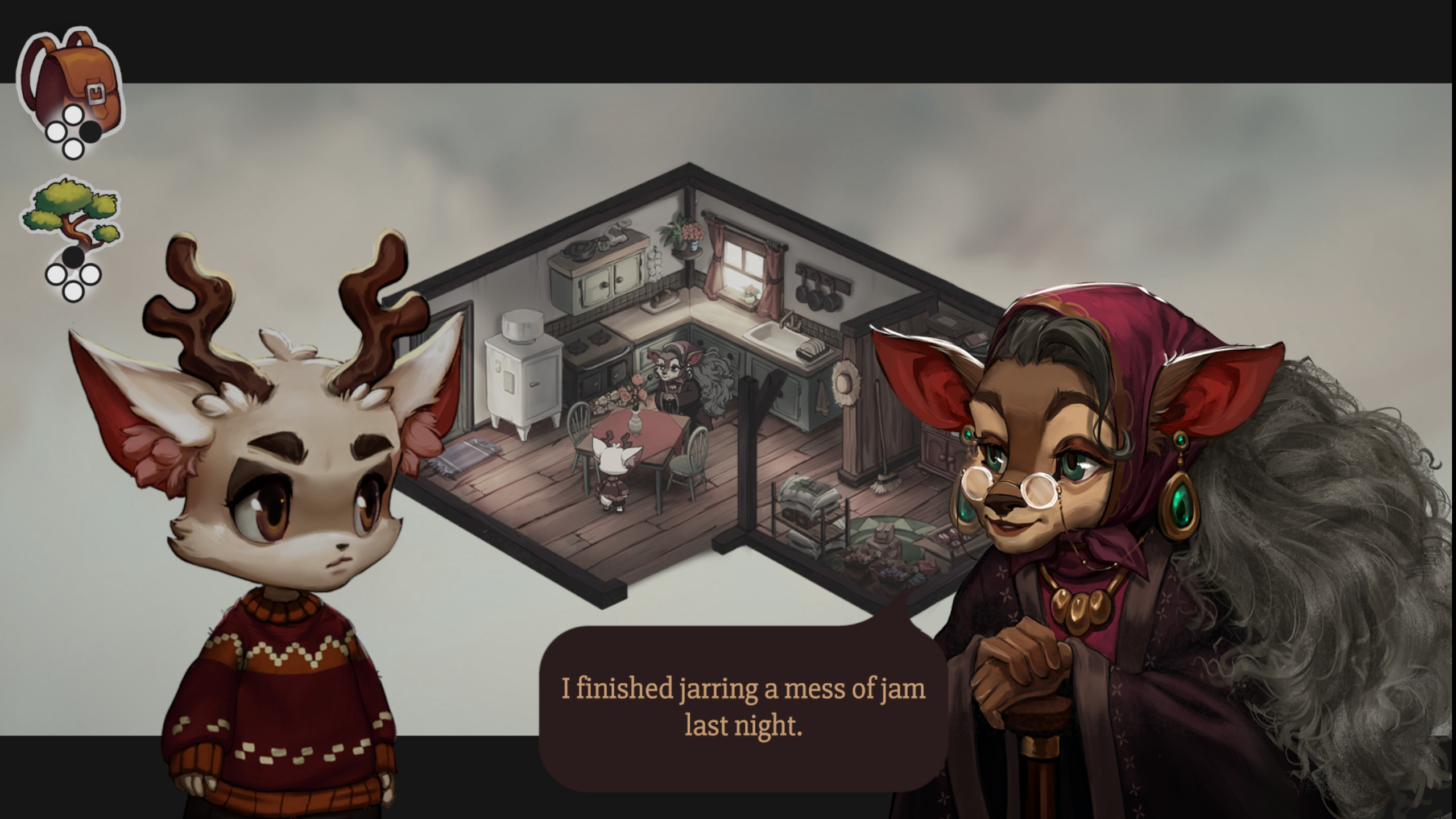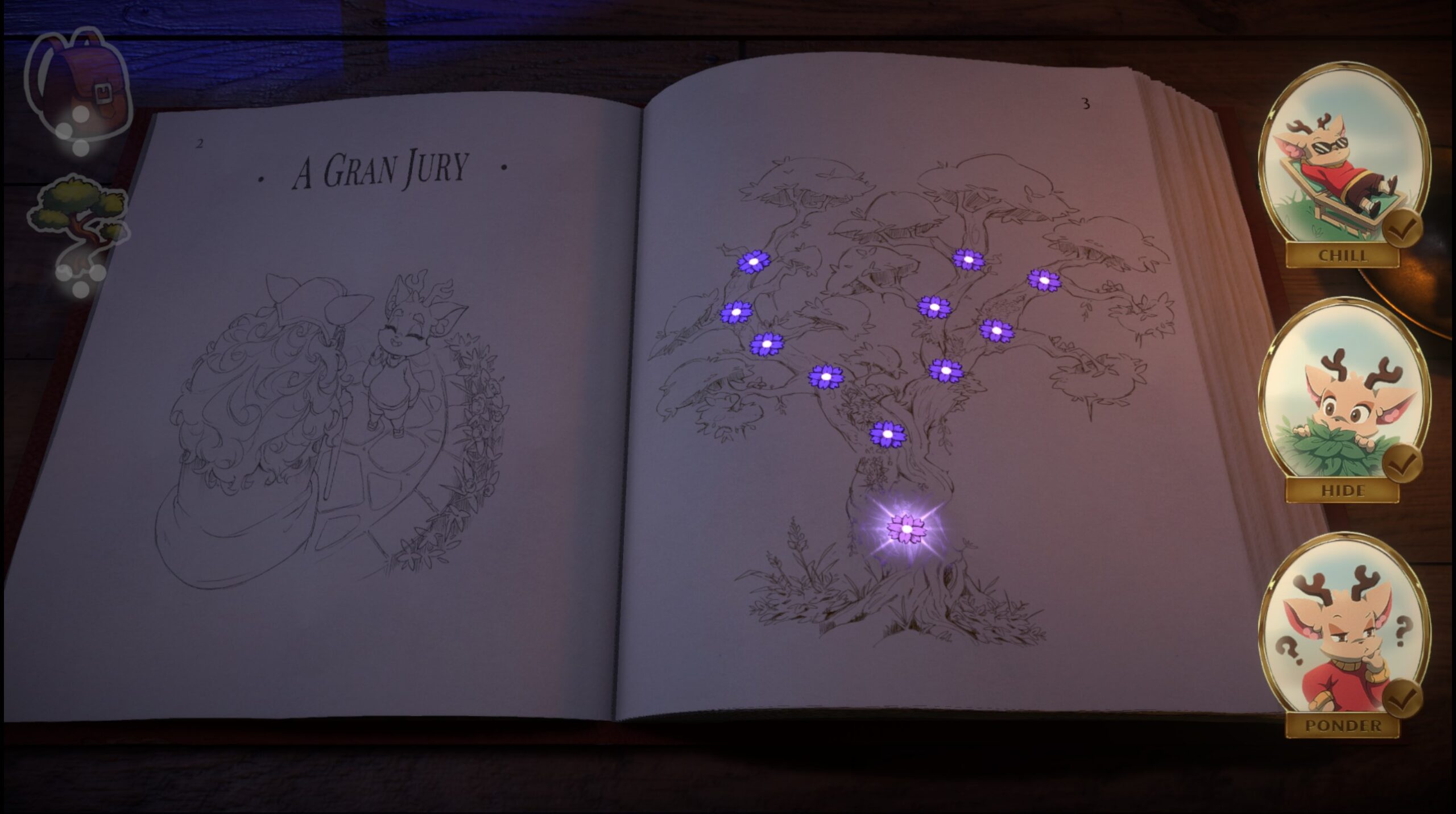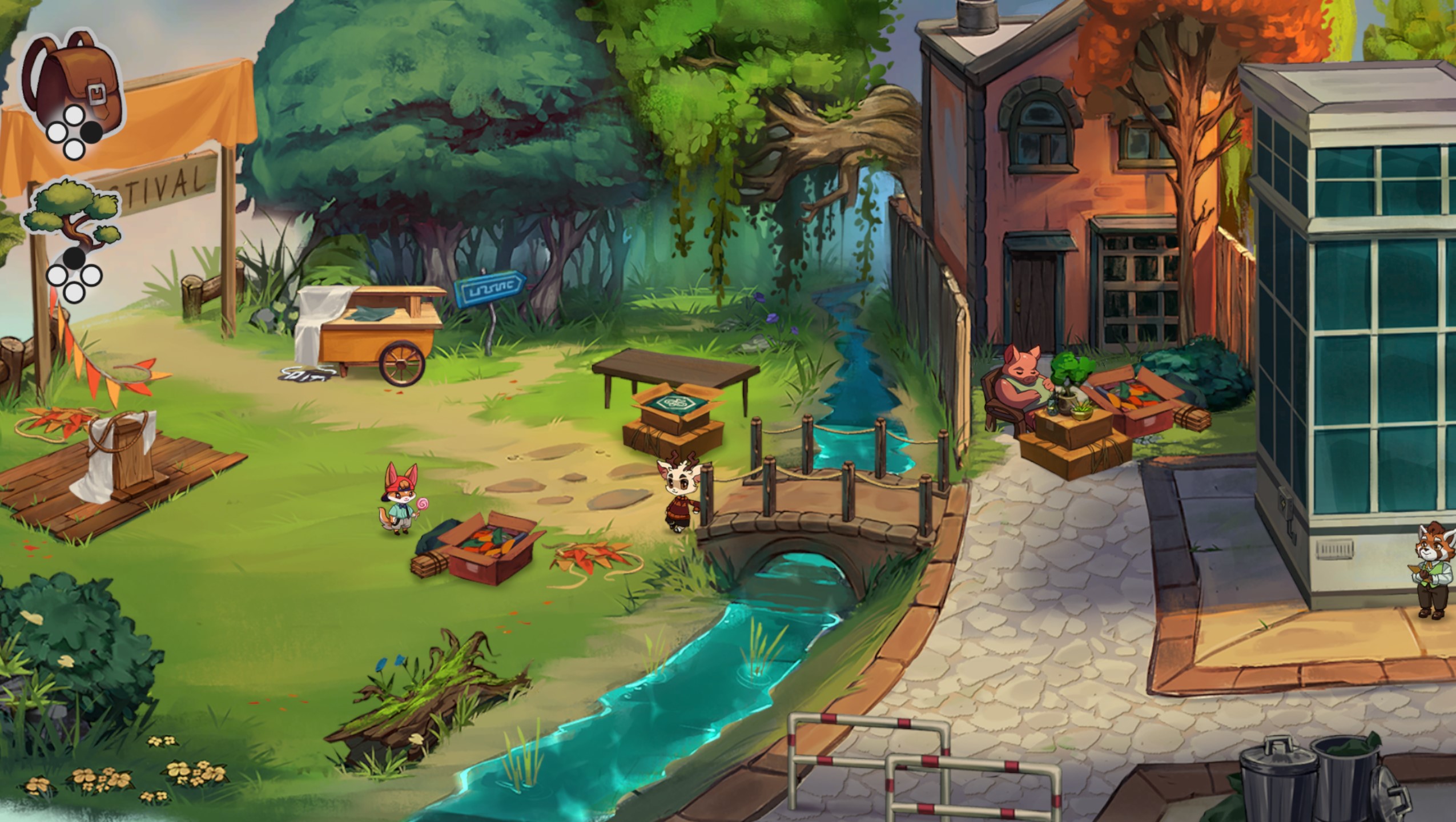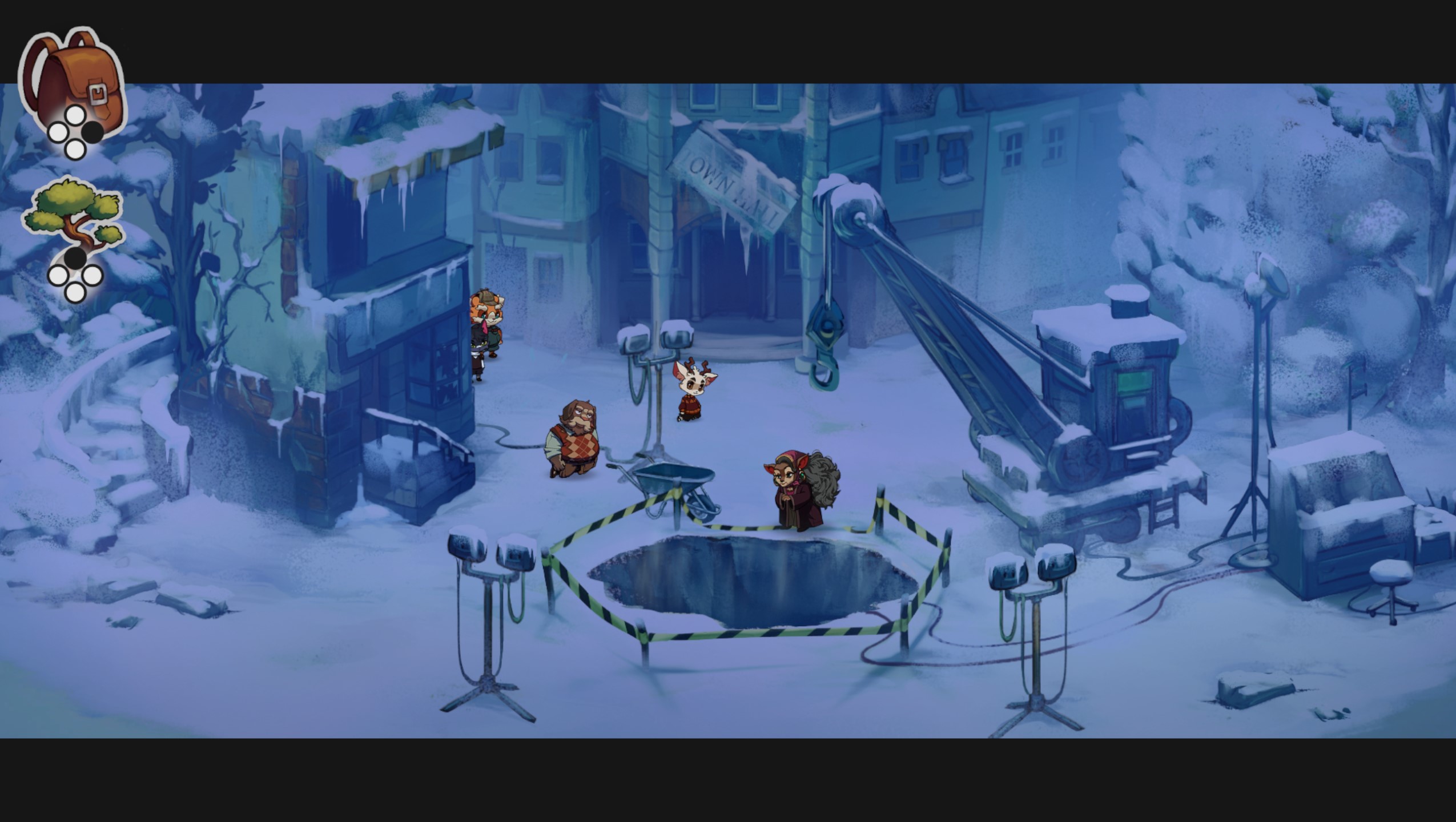Provided by Hiding Spot Games
How the Metafiction of Beacon Pines Maps a Gentler Road to Healing
You’d be forgiven for feeling, at least at first glance, that Beacon Pines’ treatment of childhood trauma within its woodland brand of cozy-spooky vibes is a little played out. Its pitch – help a boy and his friends uncover a Stranger Things-level conspiracy about their hometown and maybe accomplish some personal growth in the process – is a winning one, though certainly nothing new.
But Beacon Pines has an ace in the hole that elevates its premise from a sweetly scary fairy tale to a surprisingly thoughtful consideration of how healing works. Beacon Pines’ metaficitional narrator invites players directly into the storytelling space, sliding us in and out of the main narrative to showcase the winding, hypothetical roads of its protagonist’s recovery from deep personal loss. This deft little sleight-of-hand transforms Beacon Pines from a choose-your-own adventure with one good ending into a broader depiction of the delicate, recursive path back to wholeness in the face of a loss you can’t really ever understand.
The Fiction

Beacon Pines is about a twelve-year-old deer-boy named Luka VanHorn. He’s a sharp kid, living in a modest home just outside the eponymous town with his Gran. He spends his days with best bud, Rolo, trying to cope with his father’s mysterious death and his mother’s recent disappearance. Considering the circumstances, Luka puts on a pretty brave face.
The game opens on a sober scene: little Luka leaving remembrances by his father’s graveside, mourning the double loss of both his parents. When Rolo shows up full of earnest, forgetful energy, Luka graciously looks past his friends’ tactlessness. As best he can, Luka shakes off the gloom of his father’s resting place and runs out into the summer day in search of brighter adventures.
Instead, in the coming days, Luka finds that his grief is at the center a conspiratorial disaster that literally lurks beneath Beacon Pines’ placid surface. Players unravel this mystery bit-by-bit in point-and-click fashion, navigating a familiar design vocabulary of beautifully illustrated 2D scenes filled with characters to speak with and environments to explore. These environments lack the esoteric riddles of classic adventures, a la the old LucasArts games. But in their place are tiny bundles of interaction where Luka acquires new language for himself, individual words that will come in handy later as his journey grows more harrowing.
And he’ll need all the language he can muster to pick his way through a branching mystery full of dead ends, red herrings, and meandering sidebars. As players shepherd Luka along his path to healing, the game pushes us squarely into Beacon Pines’ metafictional framing, asking us to reflect on how these experiences that Luka gains throughout the adventure transform into a branching bundle of possibilities. And while there is, ultimately, a “right” answer that brings the game’s story to an end, the power of the story remains very much in its telling.
The Metafiction

Like some of its more experimental indie contemporaries (Inscryption makes a particularly interesting reference point), Beacon Pines borrows liberally from postmodern reinterpretations of classic fairy tales like Shrek or The Princess Bride in how it handles its metafictional elements. It represents the literal telling of Luka’s story in a bracketed diegesis rather than immersing players directly into Luka’s perspective. Often these reinterpretations play for fourth-wall-breaking laughs, ironizing the experiences of its characters by containing them within the safety of satire. In line with that irony, Beacon Pines bookends its story with the opening and closing of a storybook, situating the entire narrative between the covers of a fairy tale. However, Beacon Pines swaps the ironic distance of postmodern storytelling for a strangely anxious kind of co-authorship that stages all of Luka’s potential paths in a gentle exploration of hurt and healing.
The narrator of Beacon Pines approaches the relationship between game and player with a reassuring, vague confidence. She discusses our role in the story as essential to her accurate retelling of it, as though she has forgotten some key details and needs our help bridging the gaps in her memory. The narrator does not seem to know herself where these lead until their paths terminate into an ending she finds unsatisfactory. Some paths end in painful, sudden violence, others in the kind of dead end you’d expect a group of kids to encounter en route to solving a very grown-up mystery. With each unsatisfying conclusion, the narrator yanks us back to the book, back to the image of a slowly blooming tree, itself an echo of the tree under which Luka’s father rests.
With each new fork of the tree’s branches, the narrator asks players to select a single, pivotal world to turn the storybook pages forward. Each of these moments represents a turn away from the clue-by-clue investigation of Luka and his friends toward the more choose-your-own adventure of Beacon Pines’ metanarrative. The link between these two levels of narration is simple — the words you can choose from in this little Mad Libs exercise derive from the language Luka finds for himself as he explores the town.
The Exploration

Whereas the tradition of point-and-click adventures often finds its protagonists collecting bric-a-brac from across the game environment, packing items away like a squirrel before winter, Beacon Pines presents a narrower perspective on environmental interaction. Through conversations with his neighbors, reveries by the old fishpond, and even simply relaxing in the overstuffed chair by the fire, Luka collects what the game calls “charms” — individual words that relate to whatever it was that Luka felt, learned, or discussed in the moment.
Though Luka collects these charms in the diegesis of Beacon Pines, they only come into play during the metafictional storybook sequences where they become the keys that unlock all the game’s branching paths. With each return to the storybook tree, previous dead ends become exciting new opportunities, and these opportunities always depend on charms that players only find by exploring a parallel branch first. Playing Beacon Pines can sometimes feel like running through a series of extremely detailed hypotheticals, where each new branch is another thought experiment, fleshed out and detailed by our struggling narrator.
So, when it comes to navigating the links between fiction and metafiction, Beacon Pines has two main tricks. First, Beacon Pines hides Luka’s progression through the town’s central mystery as well as the steps toward his own healing behind exploration that the game knows won’t lead anywhere. Second, in a game where narrative progress is explicitly figured as successfully navigating a young boy’s grief, Beacon Pines pins that progress on the explicit demonstration that players have reflected on all possible choices Luka might have made.
The Return
Just before the pandemic kicked off a couple years ago, I entered therapy for the first time following a painful community implosion. Those early conversations were full of hypothetical speculations; was it my fault that these relationships detonated? How could I have saved those friendships? Did things get toxic because I didn’t try hard enough?
One of the many things I learned in those conversations was this: my therapist was quite good at guiding me through those hypotheticals. They took my panicked catastrophizing and helped me create a more imaginative space where I could take a gentler yet still direct look at all the hurt I’d gathered over those tumultuous months. In that space, I gradually uncovered that a lot of who I am was still tied up in things I never got the chance to say or do. Little bits of me were stranded up on branches I couldn’t reach, like a cat waiting for a firefighter with a notepad and a degree in community psychology to bring it down where it belongs.
I don’t mean to suggest that Beacon Pines is literally about therapy, but there is something special and familiar about the way it uses its metafiction to frame Luka’s journey back from heartbreak. Each break in the diegetic action is an opportunity to reflect on who Luka might or might not become and how all that potential is bundled up in his interactions with the world around him. To piece Luka and Beacon Pines’ livelihoods back together, we must spend a lot of time barking up the wrong branch.
All of this makes finishing Beacon Pines an unusual affair. The linear series of events that brings us to the game’s “true” ending isn’t necessarily the sequence we remember as the credits roll. Instead, scenes from the game’s parallel paths flood our recollections. Possibilities that once brought us to a dead end turned out to be exactly the moment we needed to rescue a friend, set right an argument, or unearth a great deception.

The end of Beacon Pines finds Luka in the midst of an incredible discovery. The town’s ruling class, led by its robber baron patriarch, Sharper Valentine, has displaced the entire town out from underneath the residents’ snouts. The Valentines’ ambition brought ruin to sleepy little Beacon Pines, and rather than face their failure, they manufactured a massive fiction to duplicate Beacon Pines in its entirety elsewhere, leaving behind a hollow facsimile of the original to freeze and wither.
As Luka comes to terms with this enormous deception, he returns to the site of his father’s grave, realizing that his visitations back in the Beacon Pines he thought was his home have been, in fact, visitations to no one at all. Here, in the frozen wasteland of his original hometown, lies Luka’s father, Walt VanHorn, testifying against the crimes of Beacon Pines’ aristocracy even in death.
It’s between these two graveside tableaus that the game pulls all of its fictional themes and metafictional tricks together. Luka finds healing for himself and Beacon Pines in the parallel paths of the original town and its new beginning, just as we players navigate the parallel branches of narration. Like Luka, Beacon Pines leaves us to sit beneath the tree’s branches and feel that whoever we may have been, whoever we may become, that’s exactly who we are.





